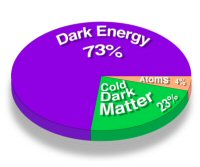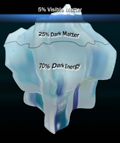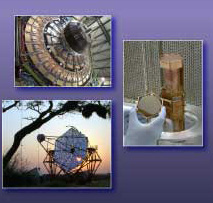Source: Robert Kirschner; NASA/WMAP Science Team
Scientists know a lot about the 4 percent of the universe that makes up visible matter such as planets and people.
But the other 96 percent remains a mystery.
What makes up that combination of undiscovered matter and cosmic energy, dubbed dark matter and dark energy, poses one of the greatest questions in modern science.
And physicists have ideas about where to find the answer. Astrophysicist Rocky Kolb, of the University of Chicago, and Fermilab particle physics theorist Joe Lykken will explain at a lecture next week in Washington, DC, how particle accelerators, satellites, telescopes, and underground detectors are preparing to shine light on dark matter and dark energy.

Photos courtesy of Fermilab
Unraveling that mystery could open the door to a radical, new understanding of our universe.
"Dark matter and dark energy are the two most important topics in all of science," says cosmologist Michael Turner, who will moderate the lecture. Last year at the Smithsonian, Turner moderated a sold-out, lively debate about String Theory, one of the most controversial concepts in particle physics.
Turner, of the University of Chicago, is known for drawing speakers out of their comfort zones with provocative questions.
"He's a master at it," says Melody Curtis, senior program coordinator for the Smithsonian Associates. "He brings out the best in people."
The lecture will be held at 7 p.m. on Wednesday, Sept. 24, at Smithsonian's National Museum of Natural History. General admission is $20.
Scientists first found evidence of dark matter in 1935. They theorized that clumps of dark matter formed the backdrop to individual galaxies, holding them together as planets and stars formed.
About a decade ago, scientists discovered that an opposite force was pushing the universe apart, expanding its boundaries at an increasing rate. This could be caused by dark energy, Turner says.
"Dark matter and dark energy are the two dark titans that have controlled the evolution of the universe," he says.
Like dark energy, dark matter has eluded direct detection so far. Other than that, the two don't seem to have much in common.
"Dark matter is unevenly distributed out there in the universe," Lykken says. "There's hunks of it here, and there's hunks of it over there.
"Dark energy, on the other hand--if it exists at all--is evenly spread out through the whole universe. So there's just as much dark energy in this office as there is in a same-sized cube out in intergalactic space."
Dark energy's gravity does not attract. Instead, it repels, like boys and girls at a middle school dance. So it's spreading itself farther and farther out.
That does not mean our galaxy will pull apart anytime soon, Turner says. "In our own galaxy, the dark energy is overwhelmed by the dark matter that's here." But understanding dark energy could give us a view of the future of the universe.
Source: SLAC and Nicolle Rager
Today, using different research tools in the three frontiers of particle physics, scientists are working together to answer questions about dark matter and dark energy.
To discover how the universe formed, scientists use particle accelerators, such as the Large Hadron Collider near Geneva, Switzerland, to replicate energies and temperatures that existed just after the big bang. Because the LHC will create energies seven times greater than any particle accelerator before it, scientists hope to produce and record particles that disappeared an instant after the big bang, including the theorized dark matter particle.
Other tools scientists hope will give them a better understanding of the origin of the universe will help them search for dark matter particles floating through the Earth and the effects of dark matter and dark energy in outer space.
Scientists have improved an experiment called the Cryogenic Dark Matter Search by adding to a collection of underground detectors they hope will identify dark matter as it passes through the Earth.
The Department of Energy and NASA are at work on plans for a Joint Dark Energy Mission, which proposes to send a telescope into space to determine whether the expansion of the universe is accelerating and if dark energy is the cause.
"This is an extraordinary time," Turner says. "There are discoveries just over the horizon. And if history is an example, we'll probably be surprised."
What it All Means
Photo courtesy of the Smithsonian
It's also possible that these types of experiments--the particle accelerator, the underground dark matter detectors, and the satellite telescope--could prove theories about dark matter and dark energy wrong.
"What that would mean is that we've actually broken through to a new level," Lykken says. "That would be great."
Basic scientific research often prompts unforeseen developments.
"When people played around with batteries and magnets," Lykken says, "it didn't seem like it was really good for anything. It turned out it was."
The idea that a rotating magnet could generate power now governs power plants across the world.
"It was that connection between magnetism and electricity that first revolutionized our society," Lykken says. "It's the reason we're not all freezing in the dark."
Another idea that only seemed useful for intellectual stimulation was quantum mechanics, formulated in the 1920s to explain the strange behavior of particles inside atoms.
"Only a dozen people in the world understood it," Lykken says. "About 30 years later, John Bardeen invented the transistor based on quantum mechanics." And that has served as the basis for electronics since.
The tools of research can also find new uses in different fields, such as medicine. Particle physics research has contributed to Computer-Aided Tomography (CAT scans), Magnetic Resonance Imaging (MRI), Positron Emission Tomography (PET scans), and cancer treatment.
Turner says he cannot predict how new understanding of dark matter and dark energy will be used but said he trusts in the power of basic research.
"In the long run, it changes not only the way we look at the universe," he says, "but it also changes the way we live--and for the better."









